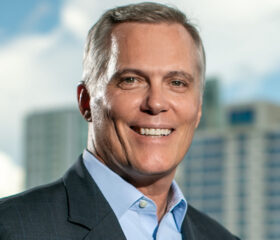Writer: Joey Garrand
2 min read December 2021 — With great growth comes great responsibility, and Tampa Bay community leaders are consistently innovating to accommodate the explosive growth the region has been experiencing. In interviews with Invest:, Dr. Bob Rohrlack, president & CEO of the Tampa Bay Chamber, and Carole Post, administrator for Development and Economic Opportunity for the City of Tampa, discussed where things stand today and the path forward for the region.
What is the current strength of Tampa Bay’s economy?

Dr. Bob Rohrlack: The airport serves as a gateway to the region, and it has had the trajectory to meet or exceed the pre-pandemic travel levels. Our members are telling us that they are as busy as they were, with their current problems being the supply chain and finding adequate workforce. Before the pandemic, the workforce was tight and that’s what we’re seeing again now. Because of this, businesses have to make sure they are proactively working to keep their team members because everyone is trying to find good talent; you’re going to lose them if you’re not taking care of them.
The economy has rebounded very quickly in Florida. Particularly here in the Tampa Bay region, we’re seeing an influx of businesses wanting to be here. However, if we do not address transportation now, transportation infrastructure will become our Achilles’ heel.
 Carole Post: We are benefiting from a lot of the relocations and continued interest in people seeing Tampa as a destination for families and businesses. It has been projected that Tampa’s population will increase by 100,000 residents by 2045. Our current population is slightly more than 400,000 now, so that is a big jump. We are looking to plan accordingly, be responsible and responsive to accommodate the growth. Having good-paying jobs is a key aspect to that. Fintech is becoming a big driver for us, as well as Medtech with the health sciences and academic medicine industry.
Carole Post: We are benefiting from a lot of the relocations and continued interest in people seeing Tampa as a destination for families and businesses. It has been projected that Tampa’s population will increase by 100,000 residents by 2045. Our current population is slightly more than 400,000 now, so that is a big jump. We are looking to plan accordingly, be responsible and responsive to accommodate the growth. Having good-paying jobs is a key aspect to that. Fintech is becoming a big driver for us, as well as Medtech with the health sciences and academic medicine industry.
What infrastructure areas do you hope to see more resources allocated to?
Rohrlack: There are two. One, connecting to the contiguous counties in our region. Tampa and Hillsborough County are the geographic center of the Tampa Bay region, and so we have a responsibility to make sure we are connecting well with the surrounding areas. Every company has employees who live across multiple counties. We have to focus on our connectivity, making it easier for people to navigate the region.
Second, we have to be focused on multimodal choices. We have to step up faster, more thoroughly and more comprehensively, whether that’s through dramatically improving the bus system in each county and connecting them strongly, creating a rail option, working on the ideas surrounding express lanes and high occupancy vehicles and so on.
How has the T3 Plan continued to progress and what are the key next steps?
Post: One of the main challenges for our community is not having a true sense of public transit in a way that serves everyone’s needs. It forces people to the fringes of our city where it is more affordable to have homes, but often results in more traffic on our roads, longer commute times, and more expenses for people at the same time that we are trying to drive that down. It’s challenging to talk about transportation separately from housing because they are linked.
Some of the things we are working on is to bring the T3 concepts together, like workforce development and sustainability. One good example of that is a project that we call the Rome Yard project, an 18-acre City-owned property that the administration recently awarded through a bid process to a developer partnership to develop 1000 housing units with around 60% designated as affordable for income-qualifying residents. The project itself is about a $300 million project with 40% of the development cost allocated to local, diverse, minority businesses. It equates to about $75 million in contracts that will be designated exclusively to the underserved community and give them an opportunity to help build the city and their own future while they are contributing to this transformative project. Lastly, every aspect of the project will have sustainable measures and materials built into it.
What is your outlook for Tampa Bay’s economy?
Rohrlack: We’re getting back to an era of hyperactivity. Florida has become hot, and Tampa Bay is hitting its stride in being a leading region within the state. However, we can’t just grow for growth’s sake. We have to make sure we have a comprehensive effort to identify and solve the issues that accompany such growth.
The business community is going to need to raise its voice and be more pointed with our elected leaders. This is a long-term effort. Elected officials may term out before they see any impact, but they still need to focus heavily on all the aspects of fixing transportation. We need to think regionally but work locally, with each county doing their part to connect to surrounding counties.
What do you see as the main challenges associated with the city’s growth?
Post: Growth at this rate is inherently accompanied by challenges and problems, mainly in housing affordability, and having sufficient supply to meet the demand. As businesses are coming here, people need to be able to find safe, affordable housing near where they live, work and play, and not be forced to migrate outside the City. That is not beneficial to our city from a tax perspective, and it drives up the need for transportation and other expenses. We would rather facilitate new housing than have to build more roads. These are real issues without easy solutions. On the bright side, we have committed leaders that have come together to address these problems.
For more information, visit:

